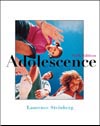Popular Media-especially advertising- are designed to influence behavior. Look at websites aimed at teenagers. What methods do advertisers and designers use to influence their audiences? Look for subtle techniques, such as product placement, as well as mote blatant bids for attention. What parallels do you see between these techniques and the kinds of peer influences adolescents experience in real life? If you found differences between the behavior of adolescents who spent time on these different sites, would you conclude that they result from the sites’ influence, or might other processes be operating as well?
Peer pressure is often subtle and comes more from our desire to be liked than
from external pressure to conform.
What are your favorite products and those of adolescents today? See if you
can find those websites. You might also start looking at screen shots from popular
movies and look to see what products are used and by whom. You can also surf
these websites to see what products are used, what clothes are worn, etc.



 2002 McGraw-Hill Higher Education
2002 McGraw-Hill Higher Education